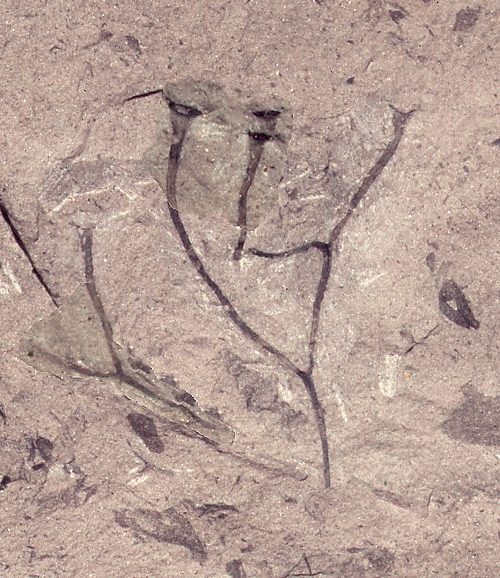 |
| Cooksonia is one of the oldest known land plants |
Animal life evolved in the seas, and in a few tens of millions of years, came to exploit all ecological niches. The land, however, was a completely untapped habitat. Dry, barren and blasted by ultraviolet radiation it was perhaps the most challenging of Earth's environments. Yet for organisms which managed to adapt and survive there was little competition to deal with. Plants and algae were the first pioneers, but exactly when they first made a move is contested. Once they had established landfall, however, other animals followed.
At 410 million years old the Rhynie Chert provides a record of the oldest terrestrial ecosystem, which includes animals and plants. Yet animals made the move before 410 million years ago. The fossil record indicates that this had occurred millions of years previously, but whether these animal pioneers could live happily on the land or were taking brief detours onto the shoreline, is unclear. Now a scorpion fossil reveals that the animal land invasion is at least 430 million years old.
 |
| A specimen of Eramoscorpius showing detail of the claws |
The new species 'is really important, because the combination of its features don't appear in any other known scorpion,' said study leader Janet Waddington, an assistant curator of palaeontology at the Royal Ontario Museum in Toronto.
Remarkably, thanks to the action of local collectors, the researchers had no less than 11 specimens of the new species. Named Eramoscorpius brucensis, its leg provides a clue as to its lifestyle.
Remarkably, thanks to the action of local collectors, the researchers had no less than 11 specimens of the new species. Named Eramoscorpius brucensis, its leg provides a clue as to its lifestyle.
The earliest known scorpion fossils suggests that the scorpion family itself first evolved in a marine environment on account of an elongation of the foot segment, the tarsus, relative to the preceding leg segment. This elongation gave them a precise footing on both irregular rocks and soft mud, both of which they would have encountered. Effectively, it walked on the tips of its toes. The tarsi in Eramoscorpius on the other hand were shorter and so could have been placed flat on the ground like regular feet. This helped spread the weight so that the creature could support itself without the buoyancy provided by water.
 |
| The largest specimen of Eramoscorpius brucensis at 165 millimetres (6.5 inches) |
It seems that the creature would have been able to walk on land but its other features, including a digestive system which required water to function, showed that it still had ties to its marine ancestry. Waddington believes that the scorpion fossils actually represent moulted shells.
In order to grow larger, arthropods must shed their exoskeletons and re-mineralise themselves shortly afterwards. The period in between leaves them vulnerable because their bodies are soft. By crawling onto land they would have been safe from predators and could moult in peace. The rocks containing the scorpion fossils often feature ripples that would have been created when wind blew thin films of water over land, suggesting a shoreline lagoon habitat.
In order to grow larger, arthropods must shed their exoskeletons and re-mineralise themselves shortly afterwards. The period in between leaves them vulnerable because their bodies are soft. By crawling onto land they would have been safe from predators and could moult in peace. The rocks containing the scorpion fossils often feature ripples that would have been created when wind blew thin films of water over land, suggesting a shoreline lagoon habitat.
Eramoscorpius and its reconstructed lifestyle provides a novel and intriguing answer as to why animals first moved out of the oceans. Other organisms may have followed in the wake of the scorpions or were one small part of a larger evolutionary radiation. Yet these new fossils will give palaeontologists an excellent starting point in the early evolution of terrestrial animals, and at the very least, offer glimpses of other land invasions in its rocks.